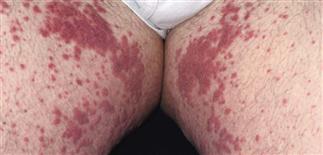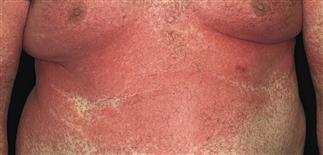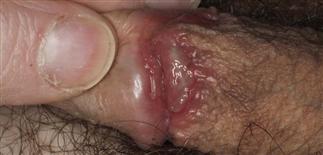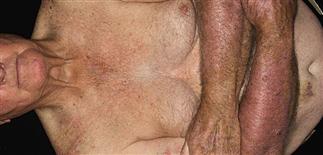84
Cutaneous drug eruptions

The torso and proximal extremities are the most common locations for cutaneous drug reactions. This patient has the typical rash characterized by red papules coalescing to plaques.

Severe drug reaction. Rash often starts on torso and can progress to full-body redness (erythroderma).

The penis is a common location for a fixed drug reaction. Sometimes they are bullous, causing deep erosions as seen in this patient.

Thiazide diuretics can produce a photosensitive drug eruption characterized by red edematous plaque with ill-defined borders on a sun-exposed surface.
DESCRIPTION
Common. Many different clinical patterns. Can mimic various dermatoses.
HISTORY
Most patients are on multiple medications. Typical sequence begins with fever followed by a rash several hours later. Rash starts on face and torso, spreading to extremities. Reaction can occur after weeks or years without ill effect, but once sensitization occurs a reaction may occur within minutes to 24–48 h. Chemically related drugs may cross-react.
Different drug reaction patterns. • Morbilliform: most common drug eruption, begins 7–10 days after starting drug, lasts 1–2 weeks. • Urticarial: frequent causes—aspirin, penicillin, blood products; IgE-mediated—immediate reaction; immune complex–mediated (serum sickness) 4–21 days after drug ingestion. • Internal–external reactions: topical sensitization to a drug results in rash after oral intake of drug. • Erythema multiforme and toxic epidermal necrolysis. • Exfoliative erythroderma. • Fixed drug reactions: appear soon after exposure and occur at same site after exposure; drug-induced hyperpigmentation. • Lichenoid drug reactions: latent period 3 weeks to 3 years. • Photosensitive reactions: phototoxic (rash within 24 h of sun exposure), photoallergic (rash after 48 h of exposure). • Small vessel necrotizing vasculitis. • Chemotherapy-induced acral erythema: caused by cytosine arabinoside, fluorouracil, doxorubicin, methotrexate • Acute generalized exanthematous pustulosis: rash within 5 days of ingestion; resolves in 15 days; penicillin most common.
PHYSICAL FINDINGS
• Morbilliform: red macules and papules that become confluent; looks like a viral exanthem; starts on trunk, spreads to extremities; can involve mucous membranes, palms, and soles; often spares the face. • Urticaria: hives, usually generalized. • Internal–external: eczematous reaction, particularly in axillae and groin. • Erythema multiforme and toxic epidermal necrolysis reactions: target lesions and widespread blistering and skin exfoliation; can involve mucous membranes. • Exfoliative erythroderma: generalized redness and scaling. • Fixed drug reactions: single or multiple round dusky-red plaques. • Drug-induced hyperpigmentation: brown to grey patches that can be in photodistributed areas (amiodarone), scars (minocycline), mucosal (zidovudine), flagellate pattern (bleomycin), melasma (oral contraceptives). • Lichenoid drug reactions: multiple flat-topped, itchy, violaceous papules; may have oral involvement. • Photosensitive: phototoxic—erythema and skin peeling confined to sun-exposed sites (can cause onycholysis); photoallergic—rash can spread to non-sun-exposed areas. • Small vessel necrotizing vasculitis: palpable purpura (especially lower legs). • Chemotherapy acral erythema: tingling on the palms and soles followed in a few days by painful, symmetric, well-defined swelling and erythema. • Acute generalized exanthematous pustulosis.
TREATMENT
Identify responsible drug and switch to chemically dissimilar drug. Symptomatic and supportive treatments.







